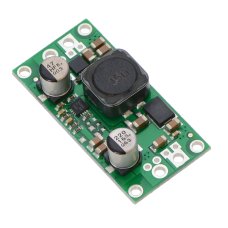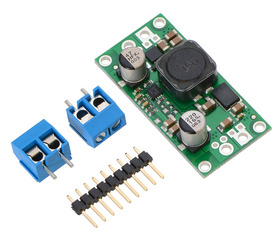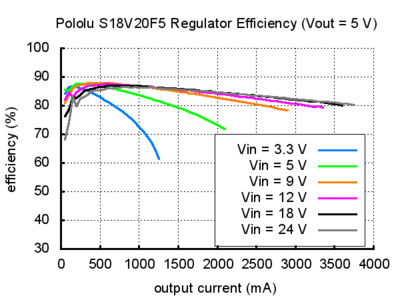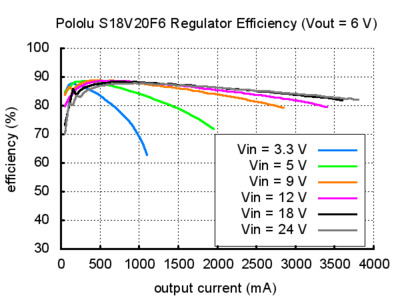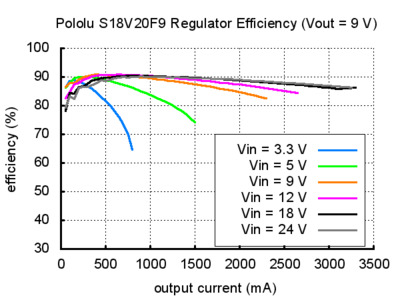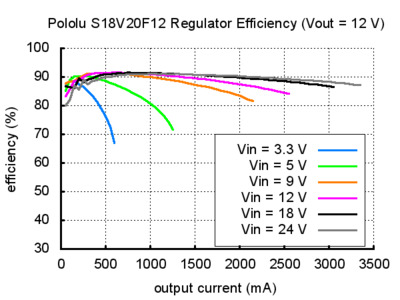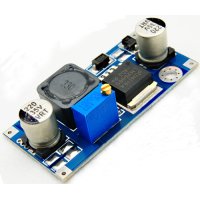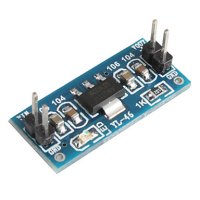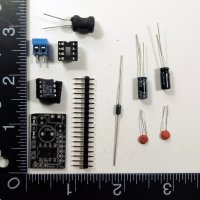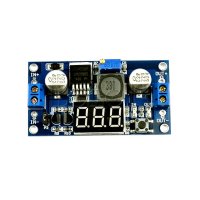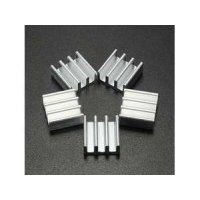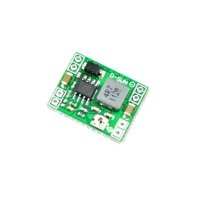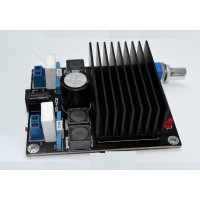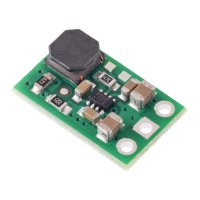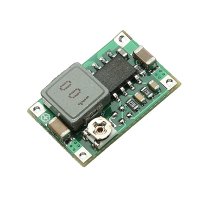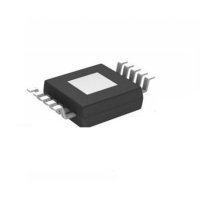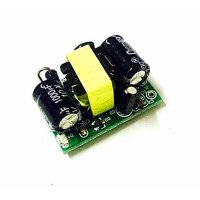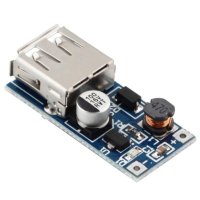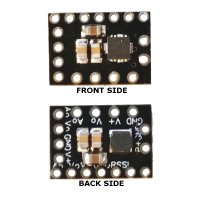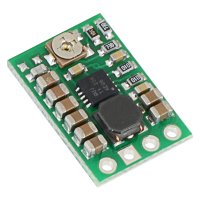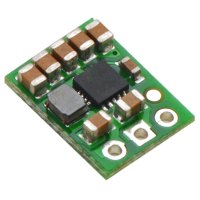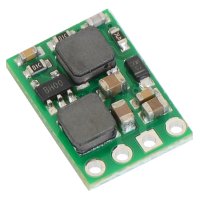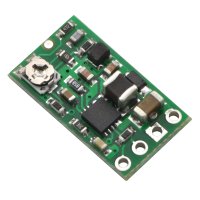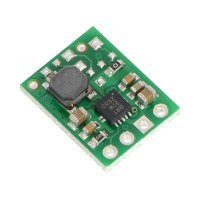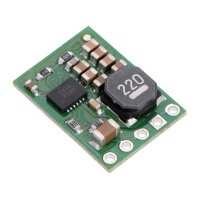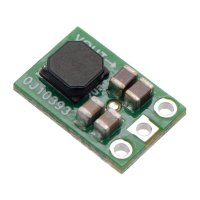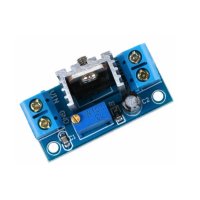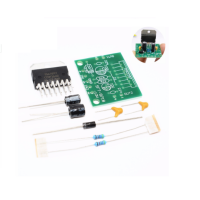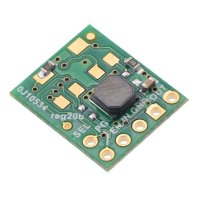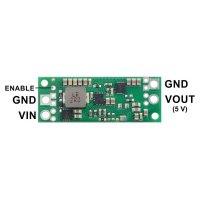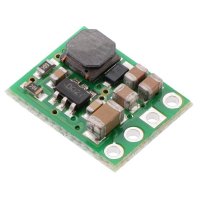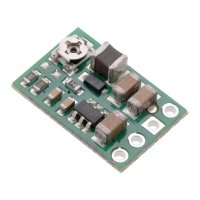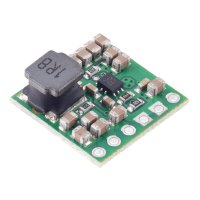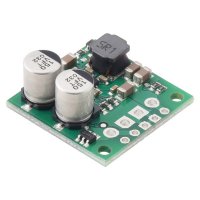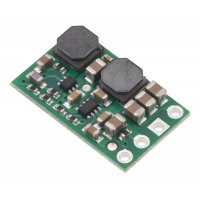This powerful S18V20F5 S18V20F6 S18V20F9 S18V20F12 step-up/step-down regulator efficiently produces a fixed 5 V/ 6V/ 9V/ 12V output respectively from input voltages between 3 V and 30 V while allowing a typical output current of up to 2 A when the input voltage is close to the output voltage and offering typical efficiencies of 80% to 90%. Its ability to convert both higher and lower input voltages makes it useful for applications where the power supply voltage can vary greatly, as with batteries that start above but discharge below the regulated voltage.
These step-up/step-down regulators take an input voltage from 3 V to 30 V and increase or decrease it as necessary to produce a fixed 5 V, 6 V, 9 V, or12 V output, depending on the version. They are switching regulators (also called switched-mode power supplies (SMPS) or DC-to-DC converters) with a single-ended primary-inductor converter (SEPIC) topology, and they have a typical efficiency between 80% and 90%. The available output current is a function of the input voltage, output voltage, and efficiency (see the Typical Efficiency and Output Current section below), but it will be around 2 A when the input voltage is close to the output voltage.
The S18V20x regulator family consists of the four fixed-output versions mentioned above along with two adjustable-output versions: the S18V20ALV offers an output range of 4 V to 12 V and the S18V20AHV offers an output range of 9 V to 30 V. The different versions of the board all look very similar, so the bottom silkscreen includes a blank space where you can add your own distinguishing marks or labels. This product page applies to all four fixed-output versions of the S18V20x family.
The flexibility in input voltage offered by these regulators is especially well-suited for battery-powered applications in which the battery voltage begins above the desired output voltage and drops below the target as the battery discharges. Without the typical restriction on the battery voltage staying above the required voltage throughout its life, new battery packs and form factors can be considered. For example:
- A 4-cell battery holder, which might have a 6 V output with fresh alkalines or a 4.0 V output with partially discharged NiMH cells, can be used with the 5V version of this regulator to power a 5 V circuit.
- A disposable 9 V battery powering a 5V circuit can be discharged to under 3 V instead of cutting out at 6 V, as with typical linear or step-down regulators.
- The 6V version of this regulator can be used to enable a wide range of power supply options for a hobby servo project.
The no-load quiescent will typically be between 1 mA and 5 mA for all possible combinations of input and output voltages (e.g. the quiescent current of the 12 V version is approximately 4 mA with 3 V in, 1.5 mA with 12 V in, and 1 mA with 30 V in). The ENABLE pin can be used to put the board in a low-power state that reduces the quiescent current to between 10 and 20 µA per volt on VIN (e.g. approximately 30 µA with 3 V in and 500 µA with 30 V in).
This regulator has built-in reverse-voltage protection, over-current protection, thermal shutdown (which typically activates at 165°C), and an under-voltage lockout that causes the regulator to turn off when the input voltage is below 2.5 V (typical).
For similarly powerful boost-only regulators, consider our U3V50x regulator family, which are typically more appropriate if you know that your input voltage will always be lower than your output voltage.
Features
- Input voltage: 2.9 V to 32 V1
- Fixed 5 V, 6 V, 9 V, or 12 V output with 4% accuracy
- Typical maximum continuous output current: 2 A (when input voltage is close to the output voltage; the Typical Efficiency and Output Current section below shows how the achievable continuous output current depends on input and output voltages)
- Integrated reverse-voltage protection (up to 30 V), over-current protection, over-temperature shutoff, and under-voltage lockout
- Typical efficiency of 80% to 90%, depending on input voltage, output voltage, and load
- Four 0.086″ mounting holes for #2 or M2 screws
- Compact size: 1.7″ × 0.825″ × 0.38″ (43 × 21 × 10 mm)
- Smaller holes for 0.1″ header pins and larger holes for terminal blocks offer several options for connecting to the board
1 32 V is the absolute maximum operating voltage; the recommended maximum operating voltage is 30 V, which is the limit of the reverse voltage protection.
Using the regulator
Connections
This step-up/step-down regulator has four connections: input voltage (VIN), ground (GND), and output voltage (VOUT), and ENABLE.
 |
The input voltage, VIN, should be between 2.9 V and 32 V. Lower input voltages can cause the regulator to shut down or behave erratically; higher input voltages can destroy the regulator, so you should ensure that noise on the input is not excessive. 32 V should be treated as the absolute maximum input voltage. Our recommended maximum operating voltage is 30 V, which is the limit of the reverse voltage protection.
The regulator is enabled by default: a 100 kΩ pull-up resistor on the board connects the ENABLE pin to reverse-protected VIN. The ENABLE pin can be driven low (under 0.7 V) to put the board into a low-power state. The quiescent current draw in this sleep mode is dominated by the current in the pull-up resistor from ENABLE to VIN and by the reverse-voltage protection circuit, which will draw between 10 µA and 20 µA per volt on VIN when ENABLE is held low (e.g. approximately 30 µA with 3 V in and 500 µA with 30 V in). If you do not need this feature, you should leave the ENABLE pin disconnected. Note that the SEPIC topology has an inherent capacitor from input to output; therefore, the output is not completely disconnected from the input even when the regulator is shut down.
The connections are labeled on the back side of the PCB, and the board offers several options for making electrical connections. You can solder the included 2-pin 5mm-pitch terminal blocks to the two pairs of larger holes on the ends of the board. Alternatively, if you want to use this regulator with a solderless breadboard, 0.1″-pitch connectors, or other prototyping arrangements that use a 0.1″grid, you can solder pieces of the included 9×1 straight male header strip to the 0.1″-spaced smaller holes (each large through-hole has a corresponding pair of these smaller holes). For the most compact installation, you can solder wires directly to the board.
 |
The board has four 0.086″ mounting holes intended for #2 or M2 screws. In applications where mounting screws are not used and wires are soldered directly to the board, the insulated part of the wires can be passed through the mounting holes for strain relief. The picture above shows an example of this with 20 AWG wire, which was close to the limit of what would fit through the mounting holes.
Typical efficiency and output current
The efficiency of a voltage regulator, defined as (Power out)/(Power in), is an important measure of its performance, especially when battery life or heat are concerns. As shown in the graphs below, these switching regulators have an efficiency of 80% to 90% for most combinations of input voltage, output voltage, and load.
We manufacture these boards in-house at our Las Vegas facility, which gives us the flexibility to make batches of regulators with customized components to better meet the needs of your project. For example, if you have an application where the input voltage will always be below 20 V and efficiency is very important, we can make these regulators a bit more efficient at high loads by replacing the 30V reverse voltage protection MOSFET with a 20V one. We can also customize the set output voltage. If you are interested in customization and want at least a few dozen units, please contact us.
The maximum achievable output current of the board varies with the input voltage but also depends on other factors, including the ambient temperature, air flow, and heat sinking. The graphs below show output currents at which this voltage regulator’s over-temperature protection typically kicks in after a few seconds. These currents represent the limit of the regulator’s capability and cannot be sustained for long periods, so the continuous currents that the regulator can provide are typically several hundred milliamps lower.
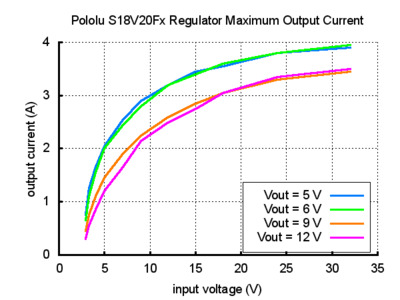 |
Dimensions
| Size: | 0.825″ × 1.7″ × 0.38″1 |
|---|---|
| Weight: | 7.5 g2 |
General specifications
| Minimum operating voltage: | 2.9 V |
|---|---|
| Maximum operating voltage: | 32 V3 |
| Maximum output current: | 2 A4 |
| Output voltage: | 5 V |
| Reverse voltage protection?: | Y5 |
| Maximum quiescent current: | 5 mA6 |
Identifying markings
| PCB dev codes: | reg14a |
|---|---|
| Other PCB markings: | 0J7765, blank white box |
Notes:
- 1
- Without included optional headers or terminal blocks. Height with terminal blocks installed is approximately 0.5″.
- 2
- Without included optional headers or terminal blocks. Terminal blocks add 3.4 g.
- 3
- Absolute maximum. Recommended maximum operating voltage is 30 V, and reverse voltage protection only works up to 30 V.
- 4
- Under typical conditions, where the input voltage is close to the output voltage. Maximum output current can be higher when stepping down and lower when stepping up.
- 5
- For input voltages up to 30 V.
- 6
- Typical worst case (i.e. with VIN at 3 V). Quiescent current depends on the input and output voltages and is much lower for most of the input voltage range. The ENABLE pin can be used to reduce the quiescent current to well under 1 mA.
-
File downloads
- Step-Up/Step-Down Voltage Regulator S18V20x drill guide (44k dxf)
- This DXF drawing shows the locations of all of the board’s holes.
| Electrical Specifications | |
| Output Voltage | 2574-5V, 2575-6V, 2576/2573-9V, 2577-12V, 2572-4V |
| Output Current | Maximum output current- 2000mA |
| Minimum Operating Voltage | 2.9V |
| Maximum Operating Voltage | 32V |
| Physical Attributes | |
| Weight | 7.5g |
| Dimensions | 0.825″ × 1.7″ × 0.38″ |
Pololu 2574/2575/2576/2577/2572/2573 5V/ 6V/ 9V/ 12V/ 4-12V/ 9-30V Step-Up/Step-Down Voltage Regulator S18V20F5/ 6/ 9/ 12/ ALV/ AHV
- Brand: Pololu
- Product Code: Pololu-5V-Step-Up-Down
- Reward Points: 22
- Availability: In Stock
- रo 2,179.00
-
रo 2,092.00
- Price in reward points: 2179
-
- 7 or more रo 2,161.00
- 13 or more रo 2,144.00
- 33 or more रo 2,127.00
- 65 or more रo 2,109.00
Available Options
Related Products
LM2596 DC to DC Step Down Adjustable Power Supply Module
Features:Adjustment method: first correct input power (between 4.5-50V) then multimeter to monitor t..
रo 90.00 रo 165.00
AMS1117 - 3.3V Power Supply Module
Key Features Input: DC 4.5V--7V Output: 3.3V, 800mA (load current can not exceed 800ma) Dual..
रo 30.00 रo 40.00
AMS1117 - 5V Power Supply Module
Key Features 1.Input: DC 6V - 12V 2.Output: 5.0V (+-0.05v error), 800mA (load current can no..
रo 102.00
Boost Kit
The Boost Shield Kit allows you to use supply voltages under 5v with the Digispark development board..
रo 220.00 रo 1,580.00
LM2596 DC to DC Step Down Module + LED Voltmeter
LM2596 Power Step-down Module DC 4.0~40 to 1.3-37V Adjustable + Voltmeter LED Display Feat..
रo 250.00 रo 485.00
Heat Sink - Aluminum with Glue (11mm)
These are high quality heat sink with heat conduction glue that can be used for dissipating the heat..
रo 13.00
XM1584 Ultra-Small Size DC-DC Step-Down Power Supply Module
XM1584 Ultra-small size DC-DC step-down 3A adjustable power supply module. Features and Specific..
रo 81.00
Amplifier Board TDA7498 100W+100W Class D
TDA7498 is 100W +100 W amplifier, using support monolithic integrated analog, logic and high pressur..
रo 1,678.00
Pololu 4940/4941/4942/4943/4944/4945/4946 Step-Up Voltage Regulator U3V16F3/5/6/7/9/12/15
This compact (0.32″×0.515″) switching step-up (or boost) voltage regulator efficiently generates 3.3..
रo 451.00 रo 470.00
DSN Mini 360 DC Adjustable Step Down Power Supply Module
Mini DC Adjustable Power Supply Buck Module Step Down Module Specifications: Modul..
रo 115.00 रo 130.00
Voltage Converter TPS5401DGQT 3.5V-42Vin,0.5A Step Down SWIFT
Voltage Converter TPS5401DGQT 3.5V-42Vin,0.5A Step Down SWIFT Specifications: Topology :..
रo 150.00
AC-DC Power Supply Buck Converter Step Down Module 5V 700mA
This power supply has the temperature protection, over current protection and short circuit protecti..
रo 140.00 रo 230.00
DC-DC Adjustable Step-up Power Converter Board 0.9V - 5V
DC-DC Adjustable Step-up Power Converter Board 0.9V - 5V Features Input volta..
रo 77.00
Regulator Step-up/ Step-Down - 5V
High precision, special design for micro FPV, easy soldering like a distribution board. No moto..
रo 1,216.00 रo 1,267.00
Pololu 2118 Adjustable Step-Up/Step-Down Voltage Regulator S7V8A
The S7V8A switching step-up/step-down regulator efficiently produces an adjustable output between 2...
रo 602.00 रo 628.00
Pololu 2122 3.3V Step-Up/Step-Down Voltage Regulator S7V8F3
The S7V8F3 switching step-up/step-down regulator efficiently produces a fixed 3.3 V output from inpu..
रo 602.00 रo 628.00
Pololu 2123 5V Step-Up/Step-Down Voltage Regulator S7V8F5
The S7V8F5 switching step-up/step-down regulator efficiently produces a fixed 5 V output from input ..
रo 602.00 रo 628.00
Pololu 2119 5V Step-Up/Step-Down Voltage Regulator S7V7F5
The S7V7F5 switching step-up/step-down regulator efficiently produces 5 V from input voltages betwee..
रo 527.00 रo 549.00
Pololu 2095 / 2096 / 2121 DC-DC Step Up Power Converter Booster - MT3608
This switching regulator uses the SEPIC topology to produce 5 V/9 V/12 V from input voltages between..
रo 844.00 रo 879.00
Pololu 2120 Adjustable Step-Up/Step-Down Voltage Regulator S8V3A
This switching regulator uses the SEPIC topology to provide a regulated output voltage that can be h..
रo 747.00 रo 778.00
Pololu 2561/2562 3.3/ 5V Step-Up Voltage Regulator U1V11F3/ U1V11F5
This compact (0.45″×0.6″) U1V11F3/ U1V11F5 switching step-up (or boost) voltage regulator efficientl..
रo 527.00 रo 549.00
Pololu 2830 / 2831 / 2832 / 2833 / 2834 1A Step-Down Voltage Regulator D24V10F3/ 5/ 6/ 9/ 12
The compact (0.5″ × 0.7″) D24V10F3/ 5/ 6/ 9/ 12 synchronous buck voltage regulator takes an input vo..
रo 754.00 रo 786.00
Pololu 2836 5V Step-Up/Step-Down Voltage Regulator S9V11F5
The S9V11F5 switching step-up/step-down regulator efficiently produces 5 V from input voltages betwe..
रo 679.00 रo 707.00
LM317 DC-DC Converter Buck Step Down Voltage Regulator
LM317 DC-DC Converter Buck Step Down Voltage Regulator Features: 1.Output ..
रo 90.00
Pololu 2873 / 2872 / 2871 / 2870 / 2836 / 2868 / 2869 5V/3.3V/2.5V Step-Up/Step-Down Voltage Regulator w/ Fixed 3V Low-Voltage Cutoff S9V11F5S6CMA/ F5/ F3S5C3/ F3S5/ F3S5CMA/ 5S6CMA/ MACMA
The S9V11x family of efficient switching regulators (also called switched-mode power supplies (SMPS)..
रo 602.00 रo 628.00
Pololu 2890/2891/2892/2893/2894/2895/2896 5V/ 6V/ 7.5V/ 9V/ 12V/ 15V/ (Adjustable 4.5-20V)Step-Up Voltage Regulator
This powerful synchronous switching boost regulator efficiently generates an output voltage of 5 V, ..
रo 1,361.00 रo 1,417.00
Pololu 3791/3792/3793/3794/3795/3796/3797 600mA Step-Down Voltage Regulator D36V6 F3/ F5/ F6 /F7/ F9/ F12/ F15
This compact (0.4″ × 0.5″) switching step-down (or buck) voltage regulator takes input voltages betw..
रo 451.00 रo 470.00
Pololu 3798/3799 600mA Step-Down Voltage Regulator D36V6 ALV/ AHV
This compact (0.4″ × 0.5″) switching step-down (or buck) voltage regulator takes input voltages betw..
रo 602.00 रo 628.00
Pololu 4012 / 4013 / 4014 / 4015 / 4016 Step-Up Voltage Regulator
The U3V40Fx family of boost (step-up) voltage regulators are high-efficiency synchronous switching r..
रo 754.00 रo 786.00
Pololu 4980/4981/4982/4983/4984/4985 3.3V/6V/7.5V/9V/12V/15V 2.5A Step-Up/Step-Down Voltage Regulator S13V25F3/F6/F7/F9/F12/F15
This synchronous switching step-up/step-down regulator efficiently produces 3.3 V / 6 V / 7.5 ..
रo 1,057.00 रo 1,101.00
Pololu 4964/4965/4966/4967/4968 3.3V/5V/6V/7.5V/9V Step-Up/Step-Down Voltage Regulator S8V9F3/F5/F6/F7/F9
This synchronous switching step-up/step-down regulator efficiently produces 3.3 V/ 5 V/6 V/ 7.5 V/ 3..
रo 702.00 रo 731.00
Tags: Pololu, 5V Step-Up/Step-Down, Voltage, Regulator, S18V20F5

